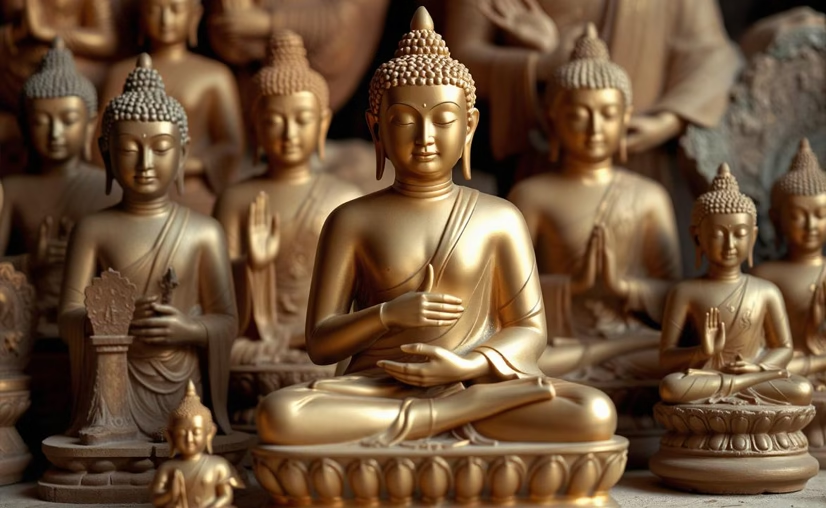
Buddha in Ancient Literature: A Life Crafted in Words
The story of Buddha exists in ancient writings through the Pali Canon and Jataka Tales along with poetic epics. The texts connect Buddha’s journey with teachings about morality and spirituality.
The journey of Gautama Buddha the enlightened teacher unfolds through ancient literature which ranges from the structured Pali Canon to the lyrical Sanskrit epic verses. The writings provide detailed accounts of his life while incorporating universal teachings into their stories. Having studied Buddhist texts for many years I find the way they create Buddha’s life story through a combination of history and myth alongside philosophical teachings remains powerful today.
Buddha in the Pali Canon
The oldest textual documentation of Buddha’s life originates from the Pali Canon which was compiled circa 1st century BCE. The Sutta Pitaka section of the Pali Canon contains discourses that describe Buddha’s final days including the Mahaparinibbana Sutta. The texts describe Buddha as a human educator who achieved enlightenment by practicing meditation and leading an ethical life. Richard Gombrich and other scholars hold that the core structure of the Canon was established within 100 years after Buddha’s passing in 483 BCE.
Key Pali Canon Accounts
- Birth and Renunciation: Siddhartha Gautama abandoned his princely life at 29 years old to pursue the truth.
- Enlightenment: At the age of 35 he achieved enlightenment while seated beneath the Bodhi tree.
- Teaching Career: Throughout his 45-year teaching career he shared the Four Noble Truths and the Eightfold Path.
Jataka Tales: Buddha’s Past Lives
The Jataka Tales within the Pali Canon illustrate Buddha’s past lives as humans and animals to demonstrate values such as compassion and sacrifice. “The Golden Deer” demonstrates his generous nature through its narrative. The Journal of Buddhist Ethics published a 2019 study that emphasized these tales’ function as ethical teaching tools across different cultures. Discover additional details in our article that explores the inspiring stories found within Jataka Tales.
Sanskrit Epics and Poetic Works
The emergence of Mahayana Buddhism during the 1st century CE gave rise to poetic narratives that documented the life of Buddha. The Sanskrit epic Buddhacarita by Ashvaghosha documents his transformation from prince to enlightened sage in vivid poetic form. Devotional readers find appeal in its lyrical style which stands in opposition to the restrained presentation of the Pali Canon. The Lalitavistara Sutra incorporates supernatural elements to depict Buddha as a divine being.
Features of Poetic Texts
- Artistic Language: The use of rich metaphors serves to transform Buddha’s story into a legendary narrative.
- Devotional Tone: Mahayana texts emphasize his cosmic significance.
- Cultural Blend: Gandharan art and texts show clear signs of Hellenistic influence.
Read the Buddhacarita at Ancient Buddhist Texts.
Why These Texts Matter Today
The ancient writings about Buddha serve dual purposes by providing historical knowledge alongside ethical and spiritual lessons. The Pali Canon teaches mindfulness through practical guidance while poetic epics evoke devotion. Research published in the 2022 edition of Religion and Literature demonstrated these narratives build empathy among readers. Both scholars and seekers will find these texts prompt thoughtful exploration of fundamental life questions.
Ways to Engage with Buddha’s Story
- Reading: Begin your journey by reading user-friendly versions of the Dhammapada or Buddhacarita.
- Meditation: Reflect on Buddha’s teachings during practice.
- Discussion: Join forums to explore texts with others.
- Art and Literature: Study Gandharan sculptures or modern retellings.
Read our post on Mindfulness Practices from Buddhist Traditions for additional information.
FAQ: Buddha in Ancient Literature
- Q: What depiction of Buddha do ancient Buddhist texts reveal to readers?
- A: Ancient Buddhist literature presents Buddha as a teacher in human form within the Pali Canon while showing him as a moral exemplar through Jataka Tales and as a divine character in Mahayana works like Buddhacarita.
- Q: The primary ancient texts that detail Buddha’s life include the Pali Canon’s Sutta Pitaka along with Jataka Tales and Sanskrit scriptures such as Buddhacarita and Lalitavistara Sutra.
- A: The primary ancient texts that detail Buddha’s life include the Pali Canon’s Sutta Pitaka along with Jataka Tales and Sanskrit scriptures such as Buddhacarita and Lalitavistara Sutra.
- Q: The main sources for studying Buddha’s life include the Pali Canon’s Sutta Pitaka and the Jataka Tales as well as Sanskrit texts such as the Buddhacarita and Lalitavistara Sutra.
- A: The main sources for studying Buddha’s life include the Pali Canon’s Sutta Pitaka and the Jataka Tales as well as Sanskrit texts such as the Buddhacarita and Lalitavistara Sutra.
- Q: The Jataka Tales hold significance because they depict previous lives of Buddha and demonstrate his teachings about virtues such as compassion and wisdom to make his journey relatable across cultures.
- A: The Jataka Tales depict previous lives of Buddha and demonstrate his teachings about virtues such as compassion and wisdom to make his journey relatable across cultures.
- Q: Mahayana scriptures portray Buddha as possessing divine attributes and universal missions while Theravada writings concentrate on his human challenges and pedagogical contributions.
- A: While texts of Mahayana Buddhism such as the Lalitavistara underscore divine attributes and cosmic responsibilities of the Buddha they portray, Theravada scriptures highlight his personal challenges and pedagogical contributions.
- Q: Where can I access authentic ancient Buddhist texts?
- A: Authentic ancient Buddhist texts can be accessed through sources like Access to Insight and Ancient Buddhist Texts.
- Q: Access to Insight and Ancient Buddhist Texts both host translations of Buddhist literature.
- A: Access to Insight and Ancient Buddhist Texts both host translations of Buddhist literature.
Conclusion: Buddha’s Legacy in Words
Ancient writings depict Buddha’s life as a masterpiece of wisdom that combines his human challenges with elements of divine influence. These writings encourage us to investigate his teachings and bring them into modern-day practice. Please submit your preferred Buddhist tale in the comments section or subscribe to receive additional articles about spiritual knowledge!